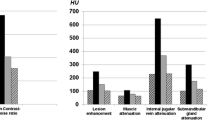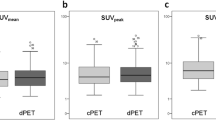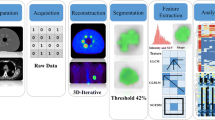Abstract
Purpose
Reconstruction parameters are an important factor in PET image quality. In the head and neck area, where the level of photon attenuation is relatively low, standard whole-body reconstruction (SWR) parameters may lead to suboptimal results. The purpose of this study was to evaluate the impact of optimised head and neck reconstruction (OHR) parameters on image quality and diagnostic accuracy, using pathology as the gold standard.
Methods
SWR parameters consisted of 2 iterations, 8 subsets and a 6-mm Gaussian filter. Predetermined OHR parameters were 4 iterations, 16 subsets and a 5-mm Gaussian filter, generating images with increased spatial and contrast resolution but also with increased noise. SWR- and OHR-based FDG-PET images of 28 patients with malignancies in the head and neck area were evaluated for primary tumour and pathological lymph nodes. Diagnostic accuracy was determined by histopathological verification after lymph node dissection.
Results
Using OHR, sensitivity for detection of a primary tumour increased from 92% to 100%. Eleven additional lymph nodes were visualised in eight patients, resulting in an increased sensitivity for lymph node metastases from 11% to 44%. Specificity decreased from 89% to 74% owing to visualisation of small reactive lymph nodes. In total, using OHR, FDG-PET diagnosis improved in six patients (21%) at the expense of three additional false positives for lymph node metastasis (11%). Primary tumour SUVmax increased by 42%, indicating enhanced contrast resolution.
Conclusion
Image reconstruction adapted to low photon attenuation in the head and neck area may improve image quality and the diagnostic value of FDG-PET, despite a slightly higher false positive rate attributable to the fact that visualisation of FDG accumulation in benign reactive lymph nodes is also enhanced.




Similar content being viewed by others
References
Stuckensen T, Kovacs AF, Adams S, Baum RP. Staging of the neck in patients with oral cavity squamous cell carcinomas: a prospective comparison of PET, ultrasound, CT and MRI. J Craniomaxillofac Surg 2000;28:319–24
Bruschini P, Giorgetti A, Bruschini L, Nacci A, Volterrani D, Cosottini M, et al. Positron emission tomography (PET) in the staging of head neck cancer: comparison between PET and CT. Acta Otorhinolaryngol Ital 2003;23:446–53
Teknos TN, Rosenthal EL, Lee D, Taylor R, Marn CS. Positron emission tomography in the evaluation of stage III and IV head and neck cancer. Head Neck 2001;23:1056–60
Braams JW, Pruim J, Freling NJ, Nikkels PG, Roodenburg JL, Boering G, et al. Detection of lymph node metastases of squamous-cell cancer of the head and neck with FDG-PET and MRI. J Nucl Med 1995;36:211–6
Laubenbacher C, Saumweber D, Wagner-Manslau C, Kau RJ, Herz M, Avril N, et al. Comparison of fluorine-18-fluorodeoxyglucose PET, MRI and endoscopy for staging head and neck squamous-cell carcinomas. J Nucl Med 1995;36:1747–57
Stoeckli SJ, Steinert H, Pfaltz M, Schmid S. Is there a role for positron emission tomography with 18F-fluorodeoxyglucose in the initial staging of nodal negative oral and oropharyngeal squamous cell carcinoma. Head Neck 2002;24:345–9
Levin CS, Hoffman EJ. Calculation of positron range and its effect on the fundamental limit of positron emission tomography system spatial resolution. Phys Med Biol 1999;44:781–99
Sanchez-Crespo A, Andreo P, Larsson SA. Positron flight in human tissues and its influence on PET image spatial resolution. Eur J Nucl Med Mol Imaging 2004;31:44–51
Schoder H, Erdi YE, Chao K, Gonen M, Larson SM, Yeung HW. Clinical implications of different image reconstruction parameters for interpretation of whole-body PET studies in cancer patients. J Nucl Med 2004;45:559–66
Hudson HM, Larkin RS. Accelerated image reconstruction using ordered subsets of projection data. IEEE Trans Med Imag 1994;13:601–9
DeGrado TR, Turkington TG, Williams JJ, Stearns CW, Hoffman JM, Coleman RE. Performance characteristics of a whole-body PET scanner. J Nucl Med 1994;35:1398–406
Wienhard K, Dahlbom M, Eriksson L, Michel C, Bruckbauer T, Pietrzyk U, et al. The ECAT EXACT HR: performance of a new high resolution positron scanner. J Comput Assist Tomogr 1994;18:110–8
Boellaard R, Buijs F, de Jong HW, Lenox M, Gremillion T, Lammertsma AA. Characterization of a single LSO crystal layer high resolution research tomograph. Phys Med Biol 2003;48:429–48
Kubota R, Yamada S, Kubota K, Ishiwata K, Tamahashi N, Ido T. Intratumoral distribution of fluorine-18-fluorodeoxyglucose in vivo: high accumulation in macrophages and granulation tissues studied by microautoradiography. J Nucl Med 1992;33:1972–80
Hsu CH. A study of lesion contrast recovery for iterative PET image reconstructions versus filtered backprojection using an anthropomorphic thoracic phantom. Comput Med Imaging Graph 2002;26:119–27
Lartizien C, Kinahan PE, Swensson R, Comtat C, Lin M, Villemagne V, et al. Evaluating image reconstruction methods for tumor detection in 3-dimensional whole-body PET oncology imaging. J Nucl Med 2003;44:276–90
Riddell C, Carson RE, Carrasquillo JA, Libutti SK, Danforth DN, Whatley M, et al. Noise reduction in oncology FDG PET images by iterative reconstruction: a quantitative assessment. J Nucl Med 2001;42:1316–23
Etchebehere EC, Macapinlac HA, Gonen M, Humm K, Yeung HW, Akhurst T, et al. Qualitative and quantitative comparison between images obtained with filtered back projection and iterative reconstruction in prostate cancer lesions of 18F-FDG PET. Q J Nucl Med 2002;46:122–30
Schauwecker DS, Siddiqui AR, Wagner JD, Davidson D, Jung SH, Carlson KA, et al. Melanoma patients evaluated by four different positron emission tomography reconstruction techniques. Nucl Med Commun 2003;24:281–9
Boellaard R, Krak NC, Hoekstra OS, Lammertsma AA. Effects of noise, image resolution, and ROI definition on the accuracy of standard uptake values: a simulation study. J Nucl Med 2004;45:1519–27
Buck AK, Halter G, Schirrmeister H, Kotzerke J, Wurziger I, Glatting G, et al. Imaging proliferation in lung tumors with PET: 18F-FLT versus 18F-FDG. J Nucl Med 2003;44:1426–31
Author information
Authors and Affiliations
Corresponding author
Rights and permissions
About this article
Cite this article
Vogel, W.V., Wensing, B.M., van Dalen, J.A. et al. Optimised PET reconstruction of the head and neck area: improved diagnostic accuracy. Eur J Nucl Med Mol Imaging 32, 1276–1282 (2005). https://doi.org/10.1007/s00259-005-1849-1
Received:
Accepted:
Published:
Issue Date:
DOI: https://doi.org/10.1007/s00259-005-1849-1




